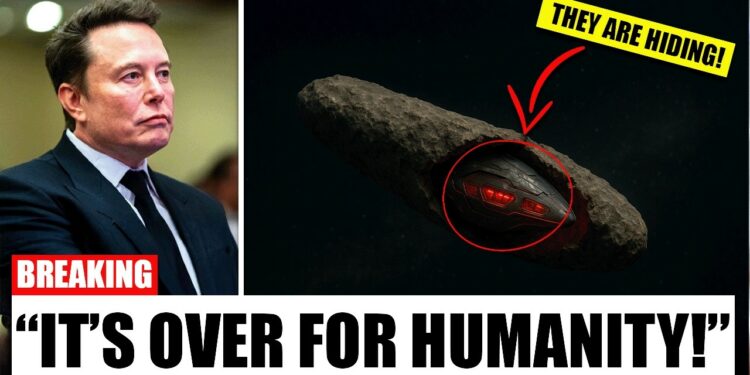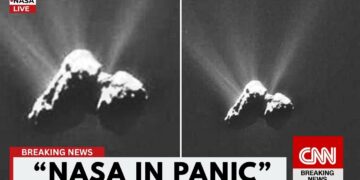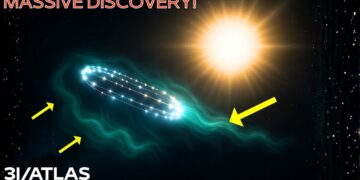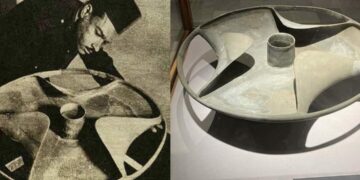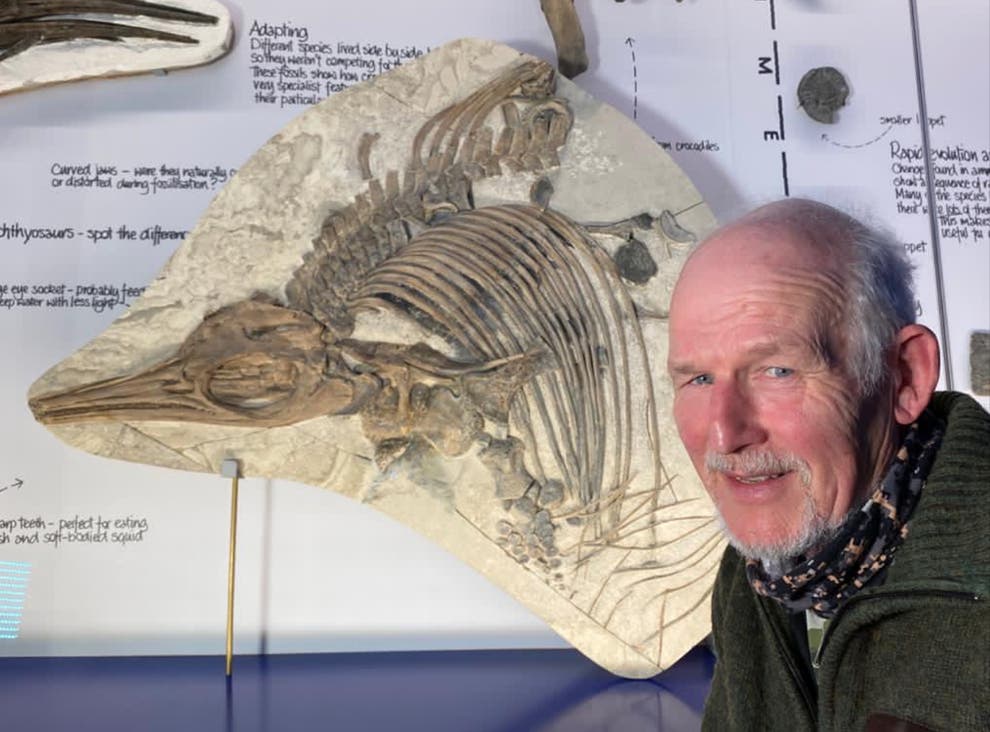There is a possibility that an intelligent life form is guiding an object toward us. Harvard astrophysicist Avi Loeb, along with two other scientists, has made a startling claim: an alien spacecraft may be concealed within a comet, posing a potential threat to humanity. This supposed comet has captured the attention of leading scientists, with Loeb suggesting it could be a piece of alien technology rather than a natural object.
This is not mere speculation. The team published a scientific paper in collaboration with NASA, titled “Is Interstellar Object 3I/LAS Alien Technology?” The object’s trajectory is unusual, lying precisely within the orbital plane of the planets around the Sun. Decades ago, Stephen Hawking warned against broadcasting signals into space, cautioning that an advanced civilization might detect and respond to them. Despite this, humanity has been sending signals into space for over a century, and now something has arrived.
Initially, NASA classified the object as a comet. However, after analyzing its precise orbit, its peculiar path past multiple planets, and its impending disappearance behind the Sun, Loeb’s team estimates a 99% chance that this is a disguised spacecraft. NASA’s trajectory illustrations support this, and the agency is reportedly developing a “Shield 3” spacecraft for rapid-response intercept missions. This video will dissect the published research, examining every scientific claim and piece of evidence suggesting this is an alien spacecraft, potentially linked to Hawking’s warning.
The object’s speed is a key indicator. Early estimates suggest it could be up to 20 km wide, roughly the size of Manhattan, though Loeb suspects it may be smaller, with its apparent size due to surrounding dust clouds. Its speed, approximately 255,000 km/h (152,000 mph), is unprecedented for a comet, as no known comet can travel this fast without external propulsion. Combined with its unusual path and precise planetary flybys, the evidence points to something more than a natural object—it aligns with what one might expect from an alien spacecraft disguised as a comet. At this speed, it could cross the United States in under two minutes, a feat mathematically impossible for a comet of this size.
The object’s trajectory raises further questions. It is perfectly aligned with the orbital plane of Earth and other planets, a thin, flat disc where our solar system resides. Its path brings it unusually close to Venus, Mars, and Jupiter, resembling a gravity-assist or slingshot maneuver used by space agencies to alter a spacecraft’s course and speed without fuel. Such maneuvers are meticulously planned years in advance for deep-space probes, and the odds of a random interstellar object achieving multiple optimal assists are calculated at 1 in 20,000. The object’s arrival is also suspiciously well-timed, originating from the direction of the Milky Way’s center, a region dense with stars, making it harder to detect until its discovery in July 2025.
Another intriguing detail is its closest approach to the Sun, which will occur when Earth is on the opposite side, around late October 2025. During this period, the object, dubbed 3L-TALS, will be hidden by the Sun’s glare, preventing optical tracking or radar contact for days or weeks. This is typical for objects near the Sun, as seen with spacecraft on Mars during solar conjunction. However, if 3L-TALS is under intelligent control, this blind period could be an opportunity to adjust its trajectory unnoticed, using its propulsion system.
Why might a comet be the perfect disguise? Loeb has long advocated for considering the possibility of interstellar technology visiting our solar system. If humans have sent probes like Voyager and Pioneer, advanced civilizations with billions of years of technological development could do the same. Disguising a spacecraft as a comet is both practical and ingenious. A comet’s rocky core, surrounded by volatile ices, produces a bright coma and tail as it nears the Sun, obscuring the object within. Telescopes cannot penetrate this haze, and a thick shell of ice and dust could shield a spacecraft from cosmic radiation, micrometeoroids, and detection. The chaotic thermal signature of venting gases would mask internal heat, and radar would scatter off the rough surface, making it indistinguishable from a natural comet. NASA has studied ice shielding for human missions, confirming its feasibility for radiation protection and resources. For a covert mission, a comet disguise is ideal, as comets are common and unremarkable in planetary systems.
Loeb’s team calculates the probabilities: a 0.2% chance of the orbital plane alignment occurring randomly, a 0.05% chance of the planetary flybys being coincidental, and the conveniently timed Sun-hidden period at perihelion. Individually, these could be dismissed as chance, but together, they suggest a designed trajectory. Stephen Hawking’s warning about broadcasting our existence adds context. He cautioned that advanced civilizations might view us as potential threats, especially as a young species advancing toward interplanetary capability. In the “dark forest” view of the universe, civilizations stay silent to avoid detection, as any noise could attract predators. By broadcasting radio, television, and deliberate signals like the Arecibo message and Voyager’s golden records, humanity has announced its presence for a century. An advanced civilization, with potentially millions or billions of years of technological progress, might see us as a risk.
If 3L-TALS is an alien craft, its mission could be exploratory or hostile. A friendly mission might involve a robotic scout collecting data, but history warns of less benign outcomes. Advanced explorers encountering less developed civilizations often brought disastrous consequences. A disguised craft could deploy smaller probes, assess our defenses, or prepare for harmful actions. If it struck Earth at its current speed, a 12-meter-wide object would release energy millions of times greater than the most powerful nuclear bomb, triggering tsunamis, global firestorms, and a dust shroud that could collapse agriculture and lead to mass extinction. If armed, the consequences could be even more catastrophic.
Rumors suggest NASA is developing “Shield 3,” a rapid-response intercept mission to study or, if necessary, disable the object. This would involve modifying a high-speed spacecraft, possibly with a nuclear payload, though matching the object’s velocity poses significant challenges. The mission would need to launch early to intercept it far from Earth. For now, it remains a concept. If the object displays typical comet behavior, such as a dust and gas plume, most astronomers will consider it natural. However, if it lacks these features or changes course after emerging from behind the Sun, it could indicate intelligent control, marking an unprecedented event.
Is 3L-TALS just an icy interstellar relic, or is it an engineered spacecraft disguised as a comet? Share your thoughts below, and follow for updates on this unfolding story.

